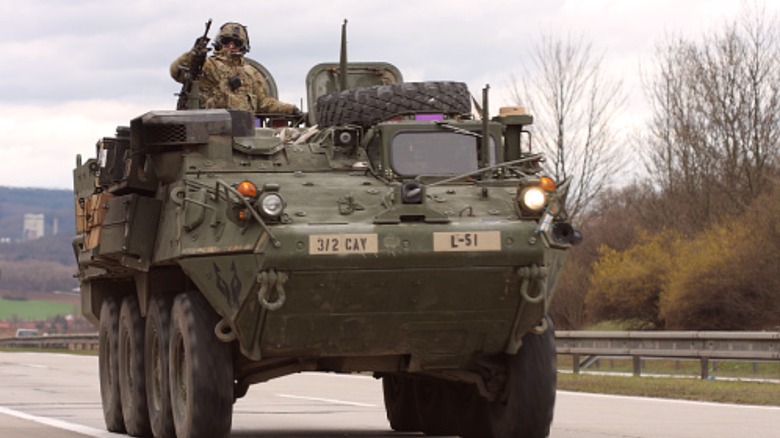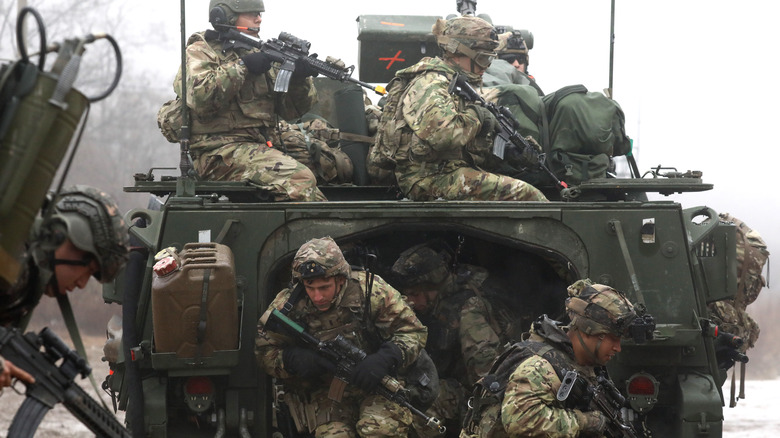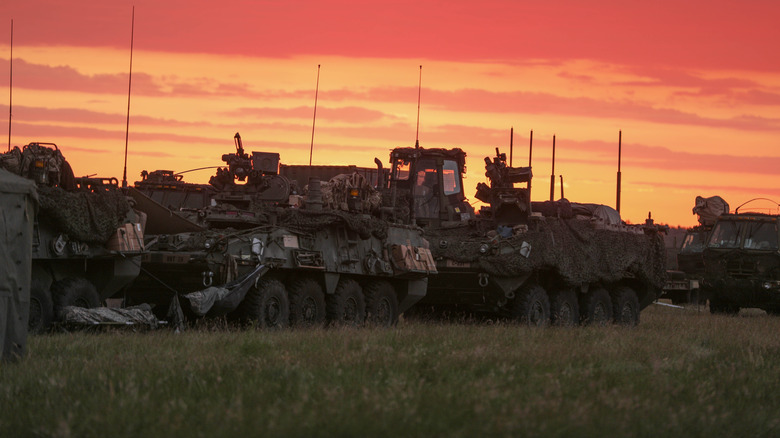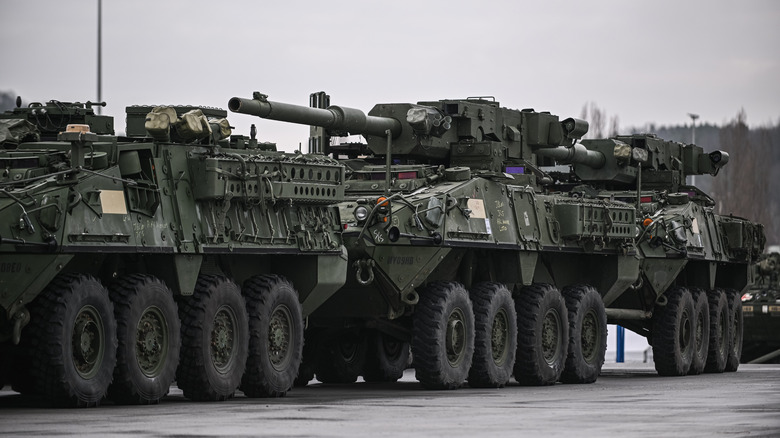The Biggest Strengths And Weaknesses Of America's M1126 Stryker
The M1126 Infantry Carrier Vehicle (ICV), otherwise known as the incredibly versatile Stryker, is one of the United States' most widely used armored vehicles. General Dynamics developed the Stryker in the early aughts to answer the need for an armored ICV that was easier to deploy than heavier vehicles like the M2 Bradley. Unlike the Bradley, Strykers are 8-wheeled vehicles capable of operating in 4x4 and 8x8 modes on blast-absorbent, non-flammable, armored tires.
Since its introduction in 2002, more than 4,900 Strykers have entered active service, most of them going to the Army. Thanks mainly to their ease of operation and transportability, the Stryker family of vehicles has taken part in every major armed conflict the U.S. Army has engaged in since its first use. Soldiers drove them on and off-road in Iraq and Afghanistan, and Strykers given to the Ukrainian military have served that country in its war against Russia.
The Stryker has an impressive track record for an up-armored vehicle that doesn't move on tracks. Its mobility allows it to drive up to 62 mph, so it's maneuverable and capable of running on many different types of terrain. Of course, like any vehicle employed by the U.S. military, Strykers have several strengths and weaknesses that amount to trade-offs for operational support over stronger defensive armor and more potent weapon systems.
It's light, tough, and packs a punch
A lot about the Stryker makes it an ideal ICV, and it has a battle-tested track record to prove that assertion. Strykers weigh 19 tons, which sounds like a lot, but they are relatively light for an armored ICV. Its wheeled chassis makes it highly maneuverable and easy to employ in any environment, and it can be outfitted with various arms and armor to meet a commander's intent on the battlefield.
With only 53 gallons of fuel in its tank, a Stryker can reach and maintain speeds exceeding 60 mph for an effective combat range of 300 miles. A quick refuel will keep them going longer, and speed isn't the only benefit of a Stryker. While the vehicle is primarily used to safely transport personnel, it's not without a weapons system. Each Stryker is typically equipped with an M2 .50 caliber machine gun or an MK19 40mm grenade launcher.
Soldiers can fire both weapon systems remotely, removing the need for personnel to operate them inside a turret. Additionally, the Stryker can support an M240 7.62mm machine gun. In terms of armor, the Stryker can protect the occupants from 14.5mm projectiles as well as 152mm artillery airburst protection. Additional armor can increase protection to survive rocket-propelled grenades (RPG) and other high-explosive arms.
A Stryker for any occasion
Numerous Stryker variants are in operation in the U.S. inventory and its allies, and plans are underway to make them into hybrid vehicles. There is also a reconnaissance vehicle, mobile gun system outfitted with a 105mm M68A1 rifled cannon, mortar carrier that boasts a 120mm mortar, command, fire support, engineer squad, medical evaluation, anti-tank guided missile, and nuclear, biological, and chemical reconnaissance vehicle.
One of the biggest strengths of the Stryker family of vehicles is its ability to incorporate upgrades with new and innovative technologies. In 2022, the Army began fielding Strykers with Directed Energy Maneuver Short-Range Air Defense (DE M-SHORAD), otherwise known as laser weapon systems. These weapons are designed primarily for defense but are more than capable of providing offensive capabilities should the Army choose to employ them in such a fashion.
The Stryker's DE M-SHORAD can generate a beam power measuring 50 kilowatts, which is necessary to knock munitions out of the sky. If 50 kilowatts doesn't sound like much, Lockheed Martin fired a 30-kilowatt laser in a test that succeeded in destroying the engine block of a pickup truck. Improvements in technology could see such weapons used offensively, though such use in combat is limited by current technological limitations of power generation and other concerns.
Maneuverability vs. survivability
While the Stryker is a proven vehicle with numerous successes in multiple theaters of war, it does have some weaknesses. There's a tradeoff when an armored vehicle isn't outfitted with the thickest possible armor. This enables maneuverability while trading survivability, which is why you should never take a Stryker to a tank fight — they are outclassed in firepower and armor, so they are susceptible to all forms of tank weapons.
Another problem with the Stryker is common for armored vehicles — it's a rollover risk. When an armored vehicle rolls over, there are numerous hazards to the people inside. They become indefensible targets, but more than that, they can take a beating through the rollover and have difficulty extricating themselves from the vehicle. Strykers have a high center of gravity and ground clearance, so rollovers can happen in and out of combat, depending on driving conditions.
Many Strykers rolled over in Iraq and Afghanistan as drivers attempted to avoid IEDs. Since IEDs can look like just about anything, drivers would swerve the vehicle to avoid trash on the side of the road, whether it was dangerous or not. Since IEDs were the deadliest hazard in Iraq, this was a common problem. Fortunately, adequate training and preparedness reduce the risk. While the Stryker has some issues, its versatility in and out of combat makes it an effective vehicle that will remain operational in the inventory for the foreseeable future.



